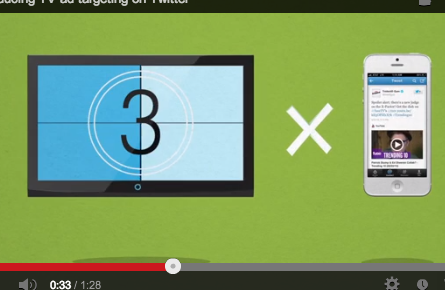Twitter’s dubious TV scheme
Jesse Brown on the social network’s broadcast gamble
Share
For those of us who get our shows via DVR, Netflix, or by various other means, television commercials are blissfully a thing of the past. But to Twitter they are somehow the future.
Here’s Twitter’s plan: they will track when and where ads are broadcast. If you tweet about a show, Twitter will figure out which ads you were shown along with that show, and then they’ll serve you Twitter versions of those ads. “What if TV commercials were just the beginning of the story?” ponders Twitter, in this promo clip explaining the plan.
But wait, there’s more! Twitter also plans to distribute video directly to its massive user-base through a media-partnership program called Twitter Amplify. They’ve struck deals with ESPN, Turner Sports, the NBA, Major League Baseball, Condé Nast Entertainment, Warner Music Group, A&E, Clear Channel, Vevo, the WWE, and Vice (whew!).
We’ve known for some time that Twitter was moving hard in this direction, and the dominant role of TV in Twitter’s strategy was underlined here by their choice of Kirstine Stewart, a career TV executive, to helm their new Canadian office. But as each new initiative (remember Vine?) is shown to revolve around video and/or television, it’s becoming clearer that all of Twitter’s eggs are being placed in television’s basket.
In tech circles, common wisdom has it that TV is: a) dying and b) the enemy. Broadcast television in particular—the kind you watch as it’s aired, without the ability to “time-shift” or speed through ads—is regarded as a gross old wheezing dinosaur. So what gives?
Here’s what Twitter’s thinking:
Dino or no, TV ads still take in $120 billion a year. Twitter hopes to make $582 million through ads this year. Needless to say, Twitter would like some of TV’s money. And they think they can get it. After all, Twitter and TV go hand-in-hand. Twitter says that 32 million Americans tweeted about television last year. By “synchronizing” TV ads with Twitter ads, Twitter also hopes to plug into the existing advertising industry, offering revenue-sharing deals to traditional ad companies who have previously regarded social media as nothing but a threat. “Everybody in digital has it wrong,” says Twitter global head of revenue Adam Bain to Ad Age magazine, “they have been going to market with an either-or proposition.”
It all seems quite savvy, a clever blend of new tech with old-fashioned deal-making. I have no doubt that advertisers will bite. But I’m not sure it’s the right move for Twitter. Here’s why:
- Everybody gets something out of this deal. Everybody, that is, except for Twitter’s 500 million users. Do you want a Twitter that “continues the story” told by TV ads? Do you want your feed of 140-character tweets clogged up by video clips with six seconds of advertising pre-roll? If the entire service gets repurposed around TV ads, users may get fed up and find something new.
- Tweeting while watching TV is still a niche activity. Personally speaking, I use Twitter a lot, but my “second screen” Twitter experience is limited to special events like political debates or The Oscars (I just don’t dig sports, okay?). When I watch engrossing fare like Breaking Bad, I’m not tweeting or checking Twitter—I’m watching. I know that sports are social, and that some people do chatter about their favourite shows on the reg, but I think this is still a minority—a minority of TV viewers, and a minority of Twitter users. A fraction of a fraction. Twitter’s stat that 32 million Americans tweeted about TV last year may be a bit misleading. The makeup of that 32 million isn’t explained, but I suspect that any American who tweeted just one thing about TV last year got counted on the list. My point is that by focusing the brunt of its ad strategy on a fraction of its users, Twitter is leaving too much value on the table.
- These new ad formats are untested. Will TV ad spots followed up by synced tweets prove effective? Will users click to watch video preceded by ads on Twitter? Who knows? The whole thing seems more like a scheme than a strategy.
- The plan minimizes Twitter’s brand. Not long ago, we spoke of Twitter as a global game-changer, the people’s open news platform, a backchannel for planning revolutions, and so on. Now, Twitter wants to be seen as added value for Swiffer commercials. One Twitter exec recently boasted that Twitter’s new goal is to amplify ads, turning the TV experience “up to eleven.” So I guess TV is the first ten, and Twitter ads one more? Seems like a shabby vision for what was supposed to be the next Gutenberg press.
- TV is overdue for a disruption. Apple, Google, Netflix, Amazon—all of these and more are pumping vast resources into developing a smart TV product that will go mainstream. Subscriptions and pay-per-view will be the norm, and the elimination of ads will be the primary incentive to get people to cut cable cords and sign on. Where will Twitter be then?
Follow Jesse on Twitter @JesseBrown
